Are you ready to explore Rome’s incredible history and architecture? This city is known as the eternal city for good reason. It’s packed with ancient ruins, iconic landmarks, and magnificent monuments from over 2,000 years ago.
The Colosseum’s vast grandeur and the Pantheon’s timeless elegance are just two examples. They invite you to travel back in time and experience the glory of Roman civilization.
Key Takeaways
- Rome is home to a vast array of must-see historical and architectural sites
- The city’s iconic landmarks span over 2,000 years of Roman history
- Exploring these sites offers a unique window into the grandeur of ancient Rome
- Visiting Rome’s top attractions is a must for any cultural and historical enthusiast
- This guide will take you through the top 10 key historical sites in Rome
History and Grandeur of the Ancient Amphitheater
The Colosseum is in the heart of Rome, showing the power of the Roman Empire. It was built in 80 AD under Emperor Vespasian’s rule, being the largest and most impressive in the ancient world.
It was a place for exciting gladiator fights, animal hunts, and executions for over 400 years. With room for more than 50,000 people, it was the main fun and cultural spot in ancient Rome. This made it a huge part of the Roman Empire‘s life.
“The Colosseum stands as a testament to the grandeur and engineering prowess of the ancient Romans, a true wonder of the ancient world.”

The Roman Forum, or Forum Romanum, was the heart of ancient Rome. It was the main spot for politics, social life, and religion for more than a thousand years. Here, important events like elections and public speeches took place. The Roman Forum shows us the rich history and culture of ancient Rome.
The area used to be marshy. It was made into a lively square with the help of the Cloaca Maxima, an early sewage system. This system helped drain the marshes, making the Forum a prominent place for activities.
Through the years, the Roman Forum changed a lot, showing ancient Rome’s shift in power and focus. Starting in the 5th century BC, it became the center for ceremonies, trials, and speeches. Even though it was overlooked in the Middle Ages, the Forum was found again in the Renaissance. Since then, it has been continuously excavated, revealing its ancient beauty.
Today, the Roman Forum is a top site for archaeology in Rome, attracting more than 4.5 million visitors each year. With a single ticket, you can also see the Colosseum and Palatine Hill. Even as time has made its mark on the Forum, its role as Rome’s social, political, and commercial center is still felt.
“The Roman Forum was the very heart of ancient Rome, a bustling public space that witnessed pivotal events in the city’s history for over a millennium.”
| Key Facts about the Roman Forum | Statistics |
|---|---|
| Annual Visitors | Over 4.5 million |
| Ticket Inclusion | Colosseum and Palatine Hill |
| Transformation Timeline | 5th century BC onwards |
| Rediscovery | Renaissance and 19th century excavations |
| Key Landmarks | Cloaca Maxima, Curia Julia, Temple of Antoninus and Faustina |
Birthplace of Rome and Ancient Ruins
At the center of The Eternal City, the Palatine Hill is where Rome was born in legend. Romulus and Remus, the twin brothers, were said to be nurtured by a she-wolf here. This happened before Romulus started the city. Over time, it became a top area for rich and powerful Romans to live.
Now, the Palatine Hill is an open-air museum. It shows how Rome began more than 2,000 years ago. This area is full of ancient stone remains.
You can see grand parts of palaces, like the Flavian Palace and the House of Augustus. These places tell us a lot about how Roman rulers lived. You will also find famous arches, like the Arch of Titus and the Arch of Constantine. They remind people of Rome’s past victories.
The ticket to visit the Palatine Hill costs €12. With this ticket, you can also see the Colosseum and the Roman Forum. It’s a great deal for those wanting to explore ancient Rome’s history and beauty.
“The Palatine Hill is the pinnacle of urban aspiration in Ancient Rome, where emperors and nobility resided in unparalleled opulence.”
If you love history or admire the Roman Empire, visiting the Palatine Hill is a must. It is where Rome began, and its ruins hold many tales.
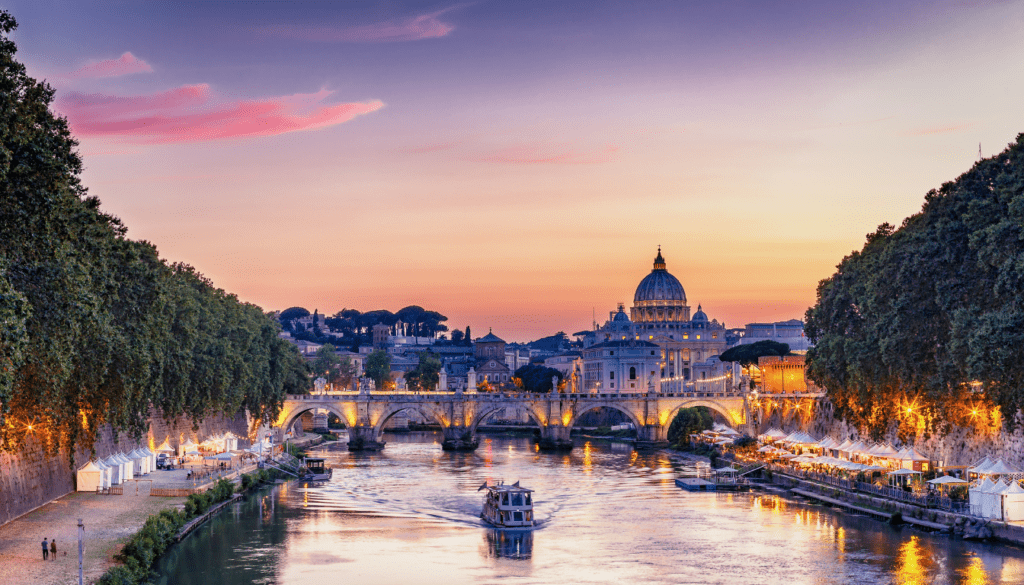
Rome is known as the Eternal City because it blends ancient history with grand architecture. It is a UNESCO World Heritage site full of must-see spots. These places take you right back to the Roman Empire’s glory days. You can visit the Colosseum, the Palatine Hill, and many other landmarks.
The Colosseum in Rome is a symbol of the city’s long history. It was built in the 1st century AD. This massive amphitheater could hold between 50,000 to 80,000 people. It was the stage for gladiatorial games and other shows. Close by, the Roman Forum shows how Romans lived in ancient times. It has well-preserved ruins and structures.
Don’t miss the Palatine Hill, which is said to be Rome’s mythical birthplace. Here, you can see the remains of lavish palaces like the Domus Flavia and the Domus Augustana. It gives you a peek into the lives of Rome’s powerful people.
Also on your list should be the Trevi Fountain, the Pantheon, and St. Peter’s Basilica. Each place has its own history and unique architecture. They are key sites for anyone excited about discovering Rome’s culture and history.
If you love history or architecture, or you just enjoy learning about different cultures, Rome has a lot to offer. The city is filled with amazing historical and architectural wonders. They make Rome a top destination for anyone interested in the ancient world.
| Landmark | Significance | Key Facts |
|---|---|---|
| Colosseum | Ancient Roman amphitheater, host to gladiatorial contests and public spectacles | Capacity of 50,000-80,000 spectators, built in the 1st century AD |
| Roman Forum | The center of ancient Roman public life, featuring well-preserved ruins | Reflects the religious, military, and political nature of the Roman Empire over a thousand years |
| Palatine Hill | Considered the mythical birthplace of Rome, featuring imperial palaces | Home to the Domus Flavia and Domus Augustana, grand imperial residences |
| Trevi Fountain | Iconic 18th-century monument, a popular tourist destination | Tradition of tossing coins into the fountain for good luck and a promise of returning to Rome |
When in Rome, visiting the Pantheon is a top choice for any traveler. This ancient Roman temple was built for pagan rituals. It stands as a symbol of ancient Rome’s amazing architecture.
The Pantheon was constructed during Emperor Hadrian’s rule, from AD 117 to 138. It’s the best-preserved structure from that time.
Once inside, the Pantheon’s beauty is stunning. Its front has huge granite columns. Visitors can’t miss the iconic dome, made of the world’s largest piece of solid concrete.
The oculus, a large hole in the dome’s top, lets sunlight in. It creates a beautiful effect and helps water drain out, too.
This temple later became a Christian church named the Basilica of Santa Maria ad Martyres. It’s still used for worship and is also a top tourist spot.
For peace in Rome, the Pantheon’s quiet pews are perfect. They are a great spot for thinking about the past and Rome’s strong influence on the world.
“The Pantheon is one of the most essential historical and architectural attractions in Rome, a true masterpiece of ancient engineering and design.”
If you love history or appreciate great architecture, the Pantheon is a must-see. It’s a memorable part of Rome, blending beauty and deep cultural meaning.

The Trevi Fountain is a famous 18th century monument in Rome. It draws many tourists who throw coins in for luck. This adds to its charm as a wellspring of fortune for those who wish to return. The fountain stands at the joining point of three important Roman streets. It is the end point of the ancient Acqua Vergine aqueduct. This aqueduct used to supply water to the Baths of Agrippa in the past.
With stories from Roman myths and legends, it is a highlight in Rome for visitors. The construction of this Baroque fountain spanned from 1732 to 1762. As a result, it stands at an impressive 26.3 meters tall and is 49.15 meters wide. This makes it one of the biggest Baroque fountains globally.
At its center stands the statue of Oceanus, the sea god, with figures showing Abundance and Salubrity. The Palazzo Poli is behind it, showcasing additional statues. These statues represent the blessings of rain and the gifts of a rich natural world.
Every day, around 1,000 to 1,200 visitors come to see the Trevi Fountain. Since the famous movie “Three Coins in the Fountain” in 1954, tossing coins in has been a tradition. The fountain collects an average of €3,000 daily from these coins. This money is then used for good causes.
“The Trevi Fountain is a remarkable Baroque art masterpiece. It stands as a symbol of Rome’s continuing cultural richness and heritage.”
Enjoying the fountain’s beauty and nearby sights, like the Acqua Vergine aqueduct, is a must. A visit to the Trevi Fountain is key for any Rome trip. It’s an experience that leaves a lasting impact.

Just a short half-hour train ride from Rome is the ancient port town of Ostia Antica. This area gives us a look at daily life in an ancient Roman port town. It served as the main port for the Roman Empire’s capital for many years, keeping many Roman ruins.
When walking through the town’s ruins, you can see where up to 100,000 people used to live. There’s the huge Roman theater and the fancy Baths of Porta Marina. The place is filled with amazing structures and items from ancient times.
Ostia Antica is great for learning about daily life for regular Romans. You can see the House of Diana to learn about where common people lived. And visit the bakery to see what they ate.
Another must-see is the Capitolium, a big temple. It was for the Roman gods Jupiter, Juno, and Minerva. Then there’s the Square of the Corporations, which shows all the jobs and goods in Ostia with its art.
For anyone into ancient Roman history or looking for a special culture trip, Ostia Antica is a top choice. It really lets you step into the past. This place is unforgettable, especially for lovers of history.
“Ostia Antica is the Roman equivalent of Pompeii, offering a glimpse into the past that is unparalleled.”
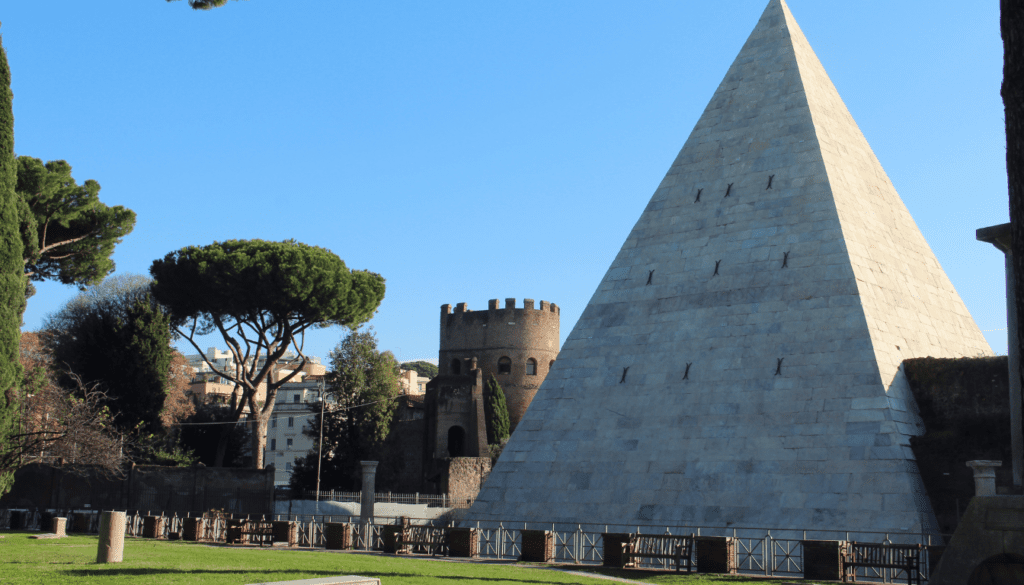
In the heart of Rome, stands the Pyramid of Cestius. It was built in the 1st century BC, showing the Roman’s love for Egyptian styles. This pyramid is a great example of Rome’s advanced architecture.
It is 36 meters (around 120 feet) tall and was made as the tomb for Gaius Cestius Epulo. What’s amazing is it was finished in just 330 days, as Cestius requested. Made from brick, cement, and white marble, it was a top site during the Grand Tour in the 18th and 19th centuries.
The pyramid was part of the Aurelian Walls from 271 to 275 AD. This change made it a useful part of Rome’s defenses and its architecture even more special.
Today, the Pyramid of Cestius is still fascinating due to its mixture of Roman architecture and Egyptian style. Despite Rome having many famous sites, this pyramid is special. It lets people connect with the ancient Romans and admire their creativity and ambition.
“The Pyramid of Cestius is a remarkable feat of engineering and design, a true testament to the Roman’s admiration for all things Egyptian.”
Visiting its exterior or taking a tour inside will leave you amazed at its beauty. While in Rome, make sure to see the Pyramid of Cestius. It’s a treasure that must be seen and cared for over many years.
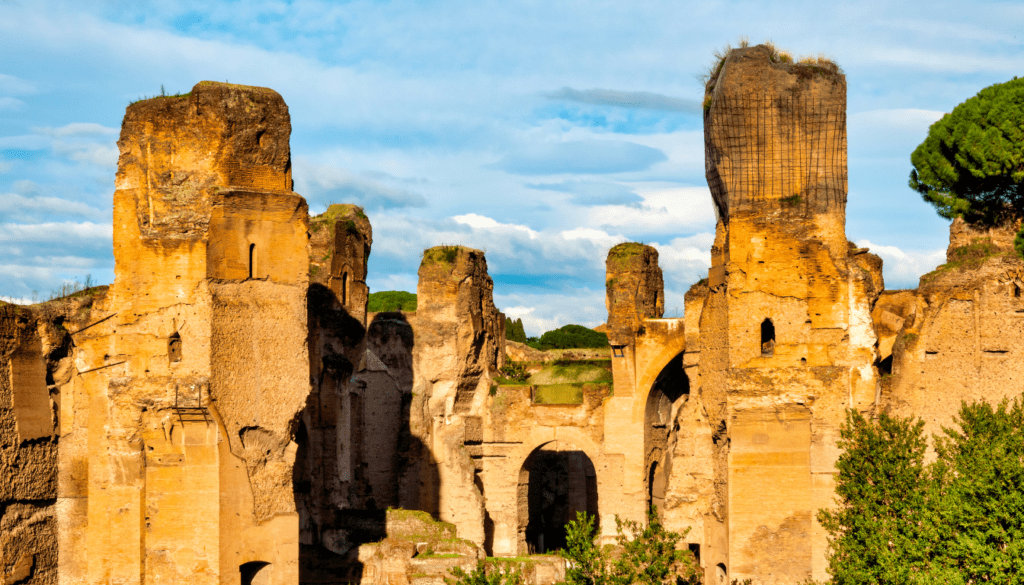
Immersing in Ancient Roman Luxury
Step back in time to ancient Rome at the Baths of Caracalla. These were once the world’s biggest baths. They were built from 298 to 306 AD by order of Roman Emperor Diocletian to honor Caracalla.
They show us the amazing skills of Roman engineers and architects. Now part of the National Roman Museum, visitors can see how large and luxurious the baths were. It could hold up to 1,600 people at once.
Today, walking through the Baths of Caracalla is like taking a trip through history. You can see the beautiful mosaics, tall columns, and the smart heating system. This system kept the baths warm, even underground.
If you love history or impressive buildings, don’t miss this place. A visit costs €8, but it’s only €2 if you’re between 18 and 25 and from the EU. It’s a great way to learn about Rome’s past.
Plan to spend a few hours there. You’ll experience the luxurious Roman bathing life. The Baths of Caracalla are a hidden treasure in Rome, waiting to be explored.
“The Baths of Caracalla stand as a testament to the remarkable engineering and architectural prowess of the ancient Romans.”
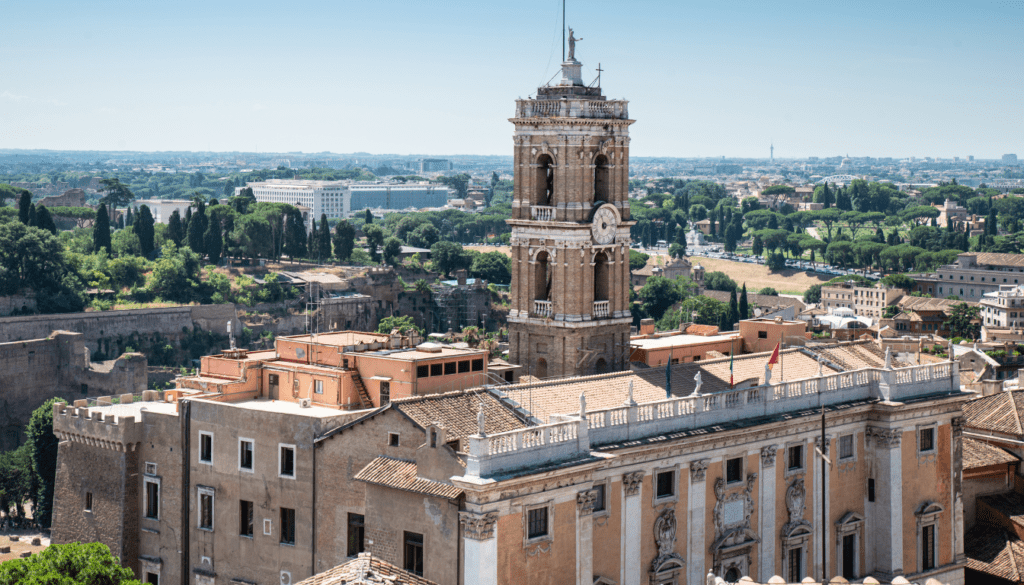
At the top of the Capitoline Hill in Rome, the Capitoline Museums shine. They hold many ancient statues and art from the Renaissance. It’s a spot that whispers about Rome’s culture for hundreds of years. The Museums started with a gift in 1471 from Pope Sixtus IV. Today, it’s one of the oldest places to see public art. This makes it a cool place to dive into the story of Old Rome.
Inside the museums, you’ll find three grand buildings. Each has its own unique charm. They are home to treasures like the Capitoline She-Wolf. This bronze shows the legend of Rome’s beginning. Visitors also find the Colossal Head of Constantine. And the mighty Hercules of the Forum Boarium. These pieces show Rome’s talents in art and design over time.
A highlight is the Capitoline Venus, a beloved ancient statue. It was found in the 1600s and it traveled a lot. Napoleon even took it to France! But, it came back to Rome in 1816. There’s also the Equestrian Statue of Marcus Aurelius. It’s an amazing piece on the Campidoglio hill. Another statue shows Commodus as Hercules. It tells about how the Roman Emperor Commodus lived and ruled.
| Artifact | Significance |
|---|---|
| Capitoline Venus | A refined classical sculpture discovered in the 1660s, taken to Paris by Napoleon, and later returned to the Capitoline Museums in 1816. |
| Equestrian Statue of Marcus Aurelius | The only surviving “equi magni” from ancient Rome, displayed atop the Campidoglio. |
| Statue of Commodus as Hercules | Portrays the extravagance and brutality of the Roman Emperor Commodus’ rule. |
| Capitoline She-Wolf | A bronze statue symbolizing the founding of Rome, donated to the city by Pope Sixtus IV in 1471. |
| Bernini’s Medusa | A 17th-century sculpture depicting Medusa entrapped in stone, created by the renowned artist Gianlorenzo Bernini. |
There are many more sculptures at the Capitoline Museums. Like the Dying Gaul, which is a copy from the Greeks. It shows a warrior dying but with great courage. And the Hall of Philosophers that has statues of famous thinkers. It shows how important smart thinking was to the Romans.
The Capitoline Museums are filled with history, beauty, and culture. They are a top pick for anyone visiting Rome. Whether you like history, art, or architecture, you will not be disappointed here. A trip to the Museums is a peek into the heart of Rome’s story.
The Temples of the Forum Boarium are among the best-preserved pieces of Roman architecture from the Republican era. They’re found in a key spot for trade and religion in ancient Rome. The Temple of Hercules Victor and the Temple of Portunus are from the 2nd century BC.
Preserved Relics of Republican Rome
These temples give us an inside look at the busy cattle market of ancient Forum Boarium. Thanks to keeping them safe, we can see the great building skills of early ancient Roman architecture.
The Temple of Hercules Victor and the Temple of Portunus show off Republican Rome‘s smart design and skillful making. Their fine details and good shape let us imagine the days when this was the city’s main spot for activity.
| Temple | Date | Architectural Features |
|---|---|---|
| Temple of Hercules Victor | 2nd century BC | Rectangular footprint, Ionic columns, high podium |
| Temple of Portunus | Around 75 BC | Rectangular footprint, Ionic colonnade, engaged columns |
The Temples of the Forum Boarium are carefully kept. They let us travel back and learn more about the ancient life in Rome. They stand as living proof of Republican Rome, and anyone interested in the city’s history should visit them.
“The Temples of the Forum Boarium give a special look at ancient Rome’s religious and business life. They bring visitors back to the lively heart of the city in its early years.”
The Curia Julia
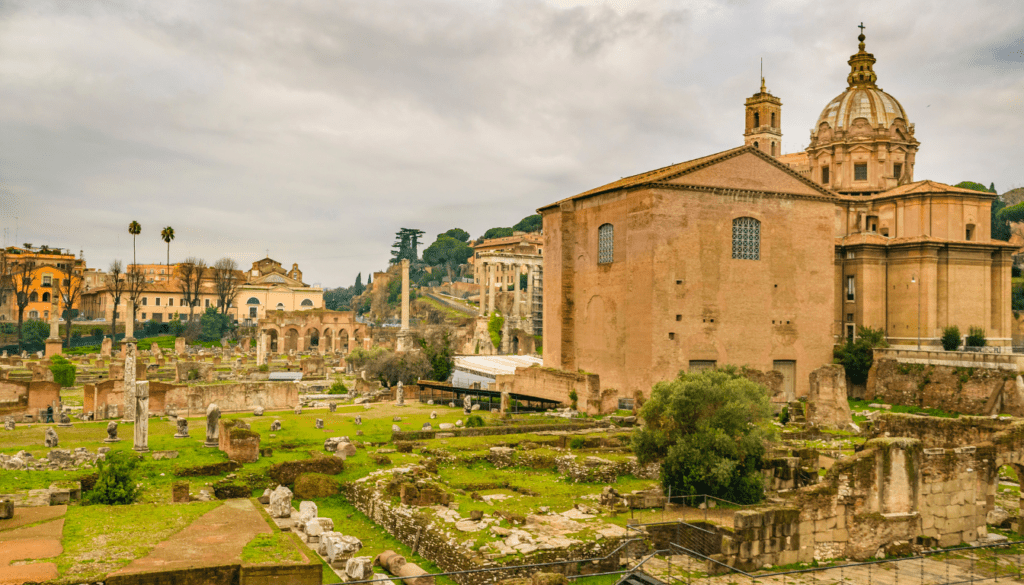
The Curia Julia is at the Roman Forum’s heart, marking ancient Rome’s history books. It was the main senate building, where Rome’s top minds met. They planned the nation’s path here.
Julius Caesar founded the Curia Julia in 44 BC. It replaced the Curia Hostilia and became a key part of the Roman Forum. Later, in 29 BC, Emperor Augustus dedicated it, underlining its importance further.
Senators in their special red togas came together here. They voted on and discussed life-changing decisions for the empire. The building is big enough for 300 of them, showing the weight of their discussions.
Withstanding time, the Curia Julia made it through Rome’s changes. In 305 AD, Emperor Diocletian fixed and saved it. This move protected it as a lasting symbol of Rome’s politics and architecture.
Today, the Curia Julia welcomes visitors to understand the Roman Senate’s workings. As you visit, feel the past come alive. You’ll imagine the grand scenes of ancient Rome in this well-preserved building.
Curia Julia,Roman Forum,senate house, ancient Rome, Julius Caesar, Diocletian
| Statistic | Value |
|---|---|
| Founding year | 44 BC |
| Completion year | 29 BC |
| Dimensions | 25.20m long by 17.61m wide |
| Capacity | Approximately 300 senators |
| Restoration date | 305 AD by Diocletian |
| Acquisition by Italian government | July 10, 1923 |
| Acquisition cost | Approximately £16,000 |
“The Curia Julia, constructed by Julius Caesar in 44 BC, was later reconstructed by Diocletian in 305 AD.”
The carefully preserved Curia Julia tells of Rome’s vastness and lasting influence. It links us to empire rises and falls, showcasing the Senate’s work. This building speaks to our shared desire to shape the world.
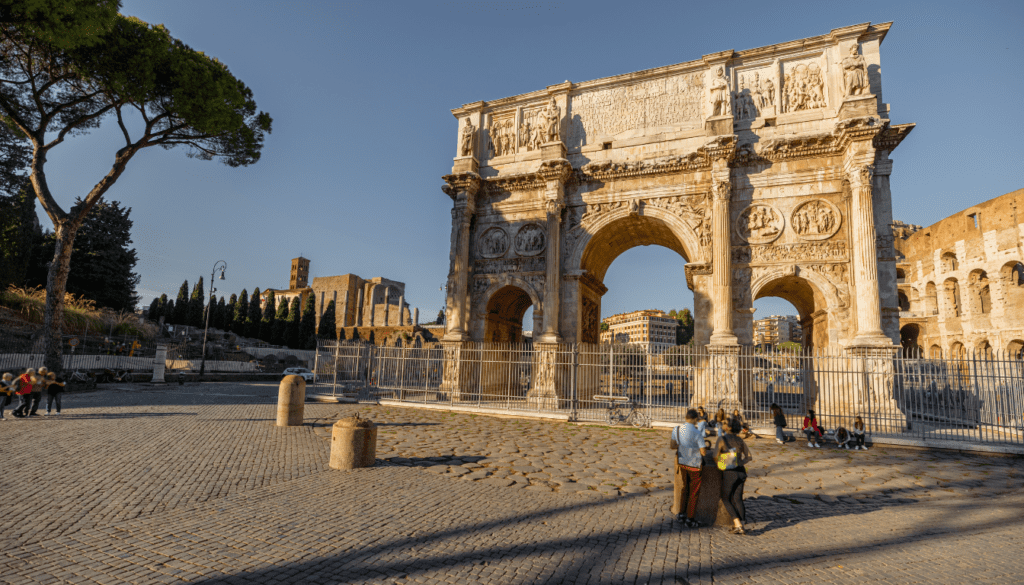
Triumphal Monument and Historic Shift
The Arch of Constantine stands between the Roman Forum and the Colosseum. It was built in AD 315 to honor Emperor Constantine’s win over Maxentius. This victory marked a big change in Roman history.
With Constantine becoming a Christian, the Arch symbolizes the end of Christian persecution in the Empire. Known as Arco di Costantino in Italian, it features beautiful decorations. These include medallions, reliefs, and statues taken from old structures, showing a move from ancient pagan beliefs to Christianity.
| Attribute | Value |
|---|---|
| Coordinates | 41°53’23″N 12°29’27″E |
| Type | Triumphal arch |
| Builder | Constantine I |
| Founded | AD 315 |
| Dimensions | 21 m (69 ft) high, 25.9 m (85 ft) wide, 7.4 m (24 ft) deep |
| Opening date | 25 July 315 |
This arch showcases the best of Roman engineering and architecture. It stands 69 feet high and 85 feet wide. Its reliefs and statues tell stories of Constantine’s military success and religious events. This shows the skill of Roman artists and the power of the Empire. It marks a key moment as Rome entered the Christian age.
“The Arch of Constantine is an iconic symbol of ancient Rome’s grandeur and conquests, exemplifying Roman architecture and engineering excellence.”
Cultural Tourism and Travel Guides
Rome, the eternal city, is a top spot for those who love cultural travel. It’s packed with old sites and amazing buildings. People from all over visit to see the grandness of ancient Rome. The Colosseum and Roman Forum are famous, but there are also hidden gems. These include the Temples of the Forum Boarium and Pyramid of Cestius. Every spot lets you peek into the city’s history.
Visitors can really connect with Rome by seeing these landmarks. They get to know the city’s rich culture and long-lasting legacy. Being a UNESCO World Heritage Site, Rome is key for cultural travel. It shows how ancient and modern can live together, making Rome special.
Good travel guides are a must for exploring Rome. They help you see the history and unique beauty of each site. Whether it’s stories about the Colosseum, the amazing Pantheon, or the views from Palatine Hill, these guides make sure you enjoy Rome’s heritage fully.
| Landmark | Fascinating Facts |
|---|---|
| The Colosseum | The Colosseum, one of Rome’s most iconic landmarks, was constructed in the 1st century AD and could accommodate up to 80,000 spectators for various events, including gladiatorial contests and public executions. |
| The Pantheon | The Pantheon, one of the best-preserved Roman monuments, features a dome with an internal diameter of 43.44 meters, making it the widest hemispherical dome ever built in unreinforced concrete. |
| Palatine Hill | Palatine Hill, considered the birthplace of Rome, is home to the remnants of grand imperial palaces and offers breathtaking views of the Roman Forum and the Colosseum. |
Traveling in Rome lets you enjoy its culture and history. With the right guides, you can explore the city’s beauty and find hidden treasures. This makes your trip both fun and enlightening, showing the lasting charm of Rome’s cultural sites.
Conclusion
Rome, known as the “Eternal City,” is filled with history and beauty over 2,000 years old. Its highlights include the mighty Colosseum and the Roman Forum, which take us back to ancient times. In addition, there are lesser-known spots like the Temples of the Forum Boarium and the Pyramid of Cestius.
Exploring Rome’s landmarks lets us connect with its past and appreciate the Roman Empire’s influence. If you love history or enjoy beautiful places, these 15 top spots are for you. They include UNESCO World Heritage sites and famous landmarks, offering a glimpse into Rome’s magnificent history.
My time in Rome showed me its resilience and global impact. Through cultural tourism and detailed travel guides, we can help keep its legacy alive. Let’s share Rome’s beauty with future generations.
FAQ
What are the must-see historical and architectural spots in Rome, Italy?
Rome is full of amazing places with over 2,000 years of history. You definitely should see the Colosseum, Palatine Hill, Pyramid of Cestius, Pantheon, Trevi Fountain, and Ostia Antica.
What is the history and grandeur of the Colosseum?
The Colosseum is unmatched, showing the might of the Roman Empire. Emperor Vespasian built it in the 1st century AD. It was the biggest amphitheater in the empire, hosting gladiator fights, hunts, and executions.
What was the significance of the Roman Forum?
The Roman Forum was ancient Rome’s heart. It was the center of politics, religion, and civic life for over a thousand years. It hosted events like elections, speeches, trials, and celebrations.
What is the history and significance of the Palatine Hill?
The Palatine Hill is where Rome is said to have begun. Legend says Romulus and Remus were raised by a she-wolf here. It also was home to Rome’s rich and powerful, who built grand palaces and villas.
What makes the Pantheon a must-see site in Rome?
The Pantheon must be visited, and it’s free to enter. It was a temple for Rome’s gods and remains the best-preserved building from ancient Rome. This shows the city’s amazing architecture.
What is the significance of the Trevi Fountain?
The Trevi Fountain is a famous 18th century monument. People toss coins into it for luck returning to Rome. It sits at a major intersection over the end of an ancient aqueduct.
What can visitors experience at Ostia Antica?
Ostia Antica offers a look at an ancient Roman port town near Rome. Visitors can see its well-preserved ruins, like a theater and temples. It’s a great way to see life in ancient times.
What makes the Pyramid of Cestius unique?
The Pyramid of Cestius is an ancient tomb in Rome. It was built like an Egyptian pyramid over 2,000 years ago. This unique pyramid marked a visit to Rome on the Grand Tour route.
What can visitors experience at the Baths of Caracalla?
The Baths of Caracalla were the biggest ancient baths once. They were a place of luxury for Romans built in the 3rd century. Now, they offer insight into Roman bathing culture and are open to the public.
What can visitors discover at the Capitoline Museums?
The Capitoline Museums are on Capitoline Hill, filled with artifacts. They have items from ancient to renaissance times. It’s a great way to explore Rome’s heritage and art.



























